Chang’e-3/Yutu Timelapse Color Panorama
This newly expanded timelapse composite view shows China’s Yutu moon rover at two positions passing by crater and heading south and away from the Chang’e-3 landing site forever about a week after the Dec. 14, 2013 touchdown at Mare Imbrium. This cropped view was taken from the 360-degree timelapse panorama. See complete 360 degree landing site timelapse panorama herein and APOD Feb. 3, 2014. . Chang’e-3 landers extreme ultraviolet (EUV) camera is at right, antenna at left. Credit: CNSA/Chinanews/Ken Kremer/Marco Di Lorenzo – kenkremer.com.
See our complete Yutu timelapse pano at NASA APOD Feb. 3, 2014: http://apod.nasa.gov/apod/ap140203.htm
Story updated[/caption]
The world famous and hugely popular ‘Yutu’ rover entered its 3rd Lunar night time hibernation period this weekend as planned, but serious technical troubles persist that are hampering science operations Chinese space managers confirmed.
“China’s lunar rover Yutu entered its third planned dormancy on Saturday, with the mechanical control issues that might cripple the vehicle still unresolved,” reports Xinhua, China’s official government news agency, in a mission status update newly released today (Feb. 23).
Yutu went to sleep on Saturday afternoon, Feb. 22, local Beijing time, according to China’s State Administration of Science, Technology and Industry for National Defence (SASTIND), responsible for the mission.
The companion Chang’e-3 lunar lander entered hibernation soon thereafter early today, Sunday, Feb 23.
See our new lunar panoramas by Ken Kremer and Marco Di Lorenzo herein and at NASA APOD on Feb. 3, 2014.

This new 360-degree time-lapse color panorama from China’s Chang’e-3 lander shows the Yutu rover at five different positions, including passing by crater and heading south and away from the Chang’e-3 lunar landing site forever during its trek over the Moon’s surface at its landing site from Dec. 15-22, 2013 during the 1st Lunar Day. Credit: CNSA/Chinanews/Ken Kremer/Marco Di Lorenzo – kenkremer.com. See our Yutu timelapse pano at NASA APOD Feb. 3, 2014: http://apod.nasa.gov/apod/ap140203.htm
Yutu first encountered a serious technical malfunction a month ago on Jan. 25, when she suffered ‘a mechanical control anomoly’ just prior to entering hibernation for the duration of Lunar Night 2.
The abnormality occurred due to the “complicated lunar surface,” according to SASTIND.
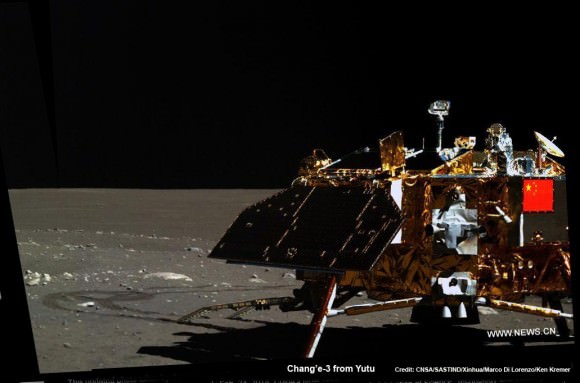
New mosaic of the Chang’e-3 moon lander and the lunar surface taken by the camera on China’s Yutu moon rover from a position south of the lander. Note the landing ramp and rover tracks at left. Credit: CNSA/SASTIND/Xinhua/Marco Di Lorenzo/Ken Kremer – kenkremer.com
Chinese space officials have not divulged the exact nature of the problems. And they have not released any details of the efforts to resolve the issues that “might cripple the vehicle.”
Since both Chinese Moon probes are solar powered, they must power down and enter a dormant mode during every two week long lunar night period when there is no sunlight to generate energy from their solar arrays. And no communications with Earth are possible.
The rover, nicknamed ‘Jade Rabbit’ remained stationary during the just concluded two week long lunar day time period, said SASTIND. It was unable to move due to the mechanical glitches.
“Yutu only carried out fixed point observations during its third lunar day.”
But it did complete some limited scientific observations. And fortunately the ground penetrating radar, panoramic and infrared imaging equipment are functioning normally.
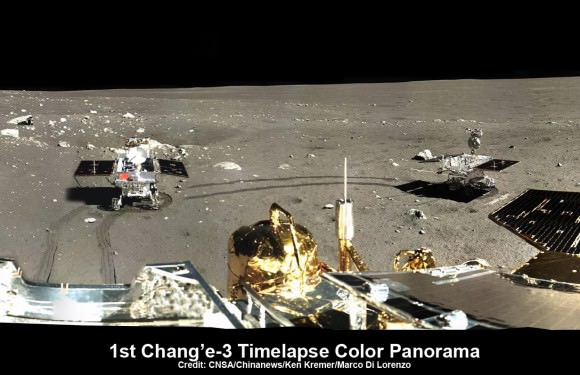
The six wheel robot’s future was placed in jeopardy after it suffered the “mechanical anomaly” in late January 2014 and then awoke later than the scheduled time on Feb. 10, at the start of its 3rd Lunar Day.
To the teams enormous relief, a signal was finally detected.
“Yutu has come back to life!” said Pei Zhaoyu, the spokesperson for China’s lunar probe program, according to a Feb. 12 news report by the state owned Xinhua news agency.
“Experts are still working to verify the causes of its mechanical control abnormality.”

This 360-degree time-lapse color panorama from China’s Chang’e-3 lander shows the Yutu rover at three different positions during its trek over the Moon’s surface at its landing site from Dec. 15-22, 2013 during the 1st Lunar Day. Credit: CNSA/Chinanews/Ken Kremer/Marco Di Lorenzo – kenkremer.com. See our Yutu timelapse pano at NASA APOD Feb. 3, 2014: http://apod.nasa.gov/apod/ap140203.htm
Since then, Chinese space engineers sought to troubleshoot the technical problems and were in a race against time to find a solution before the start of Lunar Night 3 this weekend.
“Experts had feared that it might never function again, but Yutu “woke up” on Feb. 12, two days behind schedule,” reported Xinhua.
Each lunar day and night lasts for alternating periods of 14 Earth days.
During each long night, the Moon’s temperatures plunge dramatically to below minus 180 Celsius, or minus 292 degrees Fahrenheit.
Both solar powered probes must enter hibernation mode during each lunar night to conserve energy and protect their science instruments and control mechanisms, computers and electronics.
“Scientists are still trying to find a fix for the abnormalities,” said CCTV, China’s official state television network.
So Yutu is now sleeping with the problems unresolved and no one knows what the future holds.
Hopefully Jade Rabbit awakes again in about two weeks time to see the start of Lunar Day 4.
The Chang’e-3 mothership lander and piggybacked Yutu surface rover soft landed on the Moon on Dec. 14, 2013 at Mare Imbrium (Sea of Rains) – marking China’s first successful spacecraft landings on an extraterrestrial body in history.

‘Jade Rabbit’ had departed the landing site forever, and was journeying southwards as the anomoly occurred – about six weeks into its planned 3 month long moon roving expedition to investigate the moon’s surface composition and natural resources.
The 140 kg Yutu robot is located some 100 m south of the lander.
The 1200 kg stationary lander is expected to return science data about the Moon and conduct telescopic observations of the Earth and celestial objects for at least one year.
Chang’e-3 and Yutu landed on a thick deposit of volcanic material.
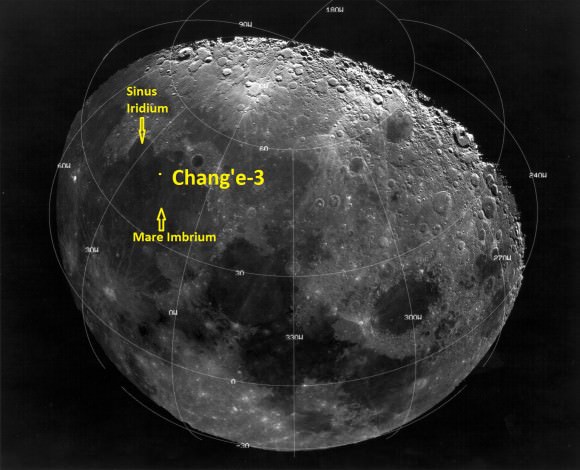
China is only the 3rd country in the world to successfully soft land a spacecraft on Earth’s nearest neighbor after the United States and the Soviet Union.
Stay tuned here for Ken’s continuing Chang’e-3, Orion, Orbital Sciences, SpaceX, commercial space, LADEE, Mars and more planetary and human spaceflight news.
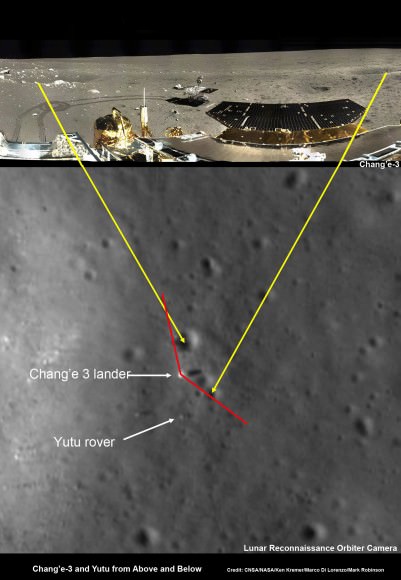
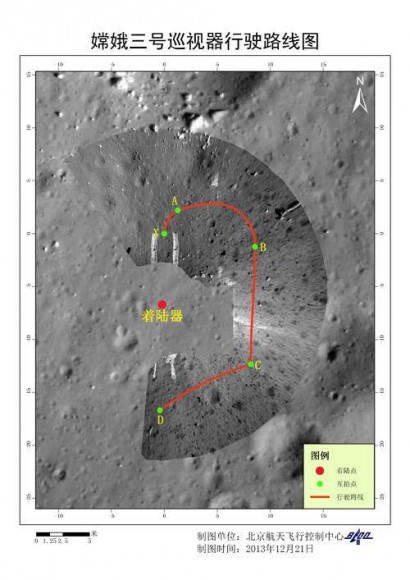

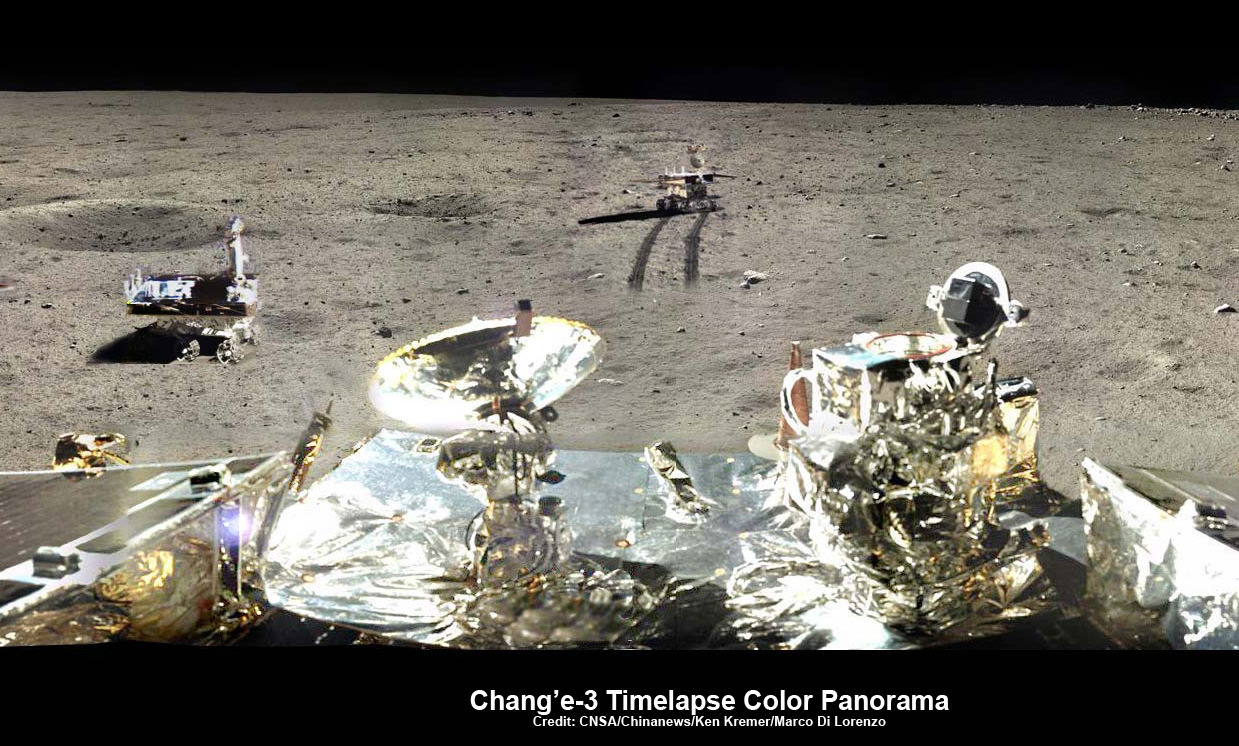
Lets just hope the batteries can withstand the low temps… again. Even if this mission isn’t a complete success, the Chinese have harvested a technological bounty learning how to control and maintain a lunar rover. The ‘Jade Rabbit’ is a real wake up call for those interested in capturing the Lunar X-prize. Getting to and operating on the moon is no picnic!